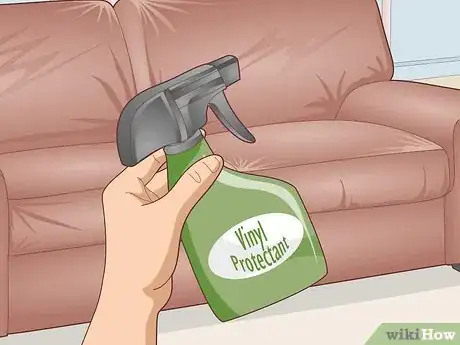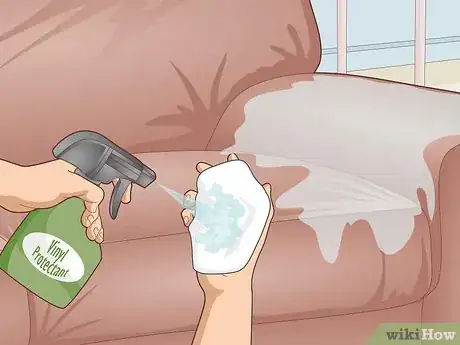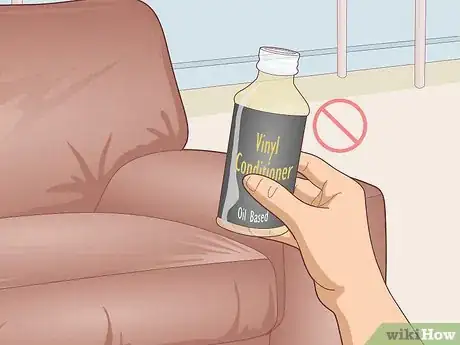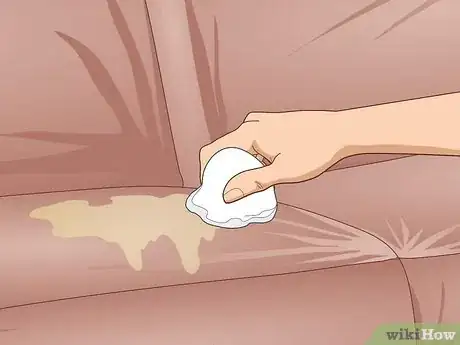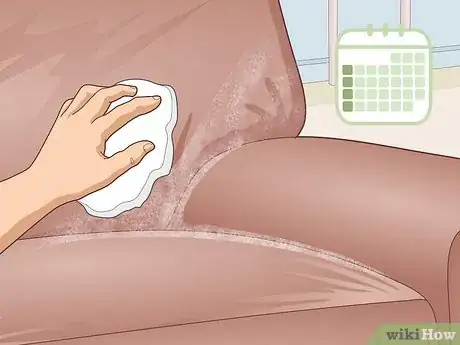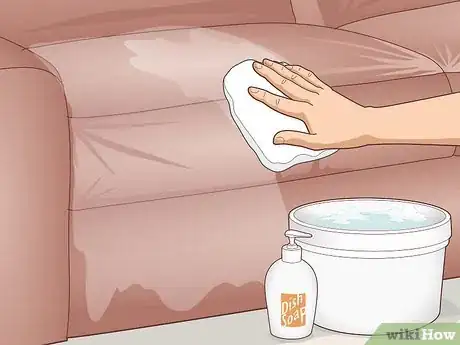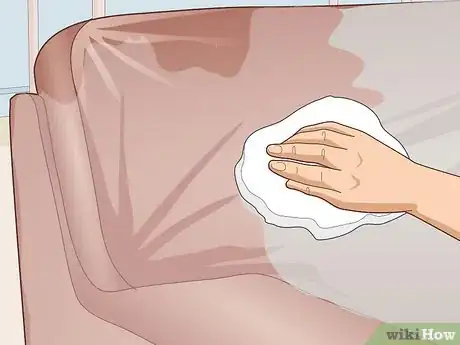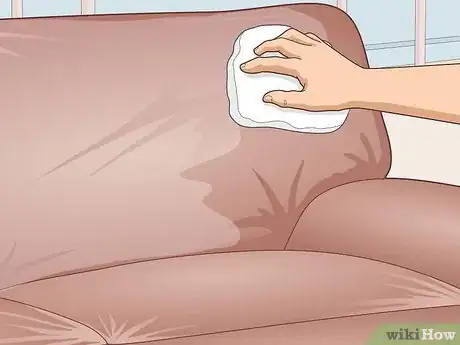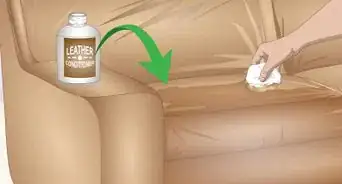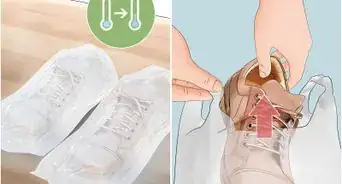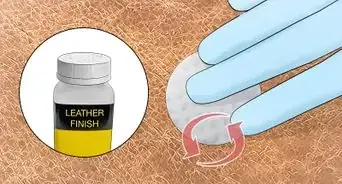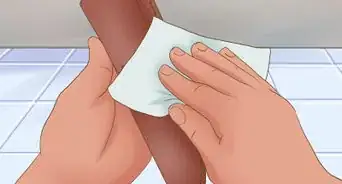This article was co-authored by Mallika Sharma and by wikiHow staff writer, Jessica Gibson. Mallika Sharma is a Certified Leather Care Technician and the Founder of The Leather Laundry, a niche spa service for luxury leather gear in India. Mallika specializes in leather cleaning, coloring, repairing, and restoring for shoes, handbags, jackets, wallets, belts, and sofas. She holds a Master’s degree in Finance and Investment from the University of Edinburgh Business School. Mallika is a certified Professional Leather Care Technician and trained with the globally reputed leather care company, LTT in the United Kingdom.
This article has been viewed 25,421 times.
Synthetic leather can look just as great as the real thing as long as you maintain it. Since synthetic leather is coated with polyurethane or vinyl, it can crack or peel if it dries out or if it's exposed to hot, humid temperatures. Fortunately, cleaning and conditioning your synthetic leather can go a long way in keeping it looking good as new!
Steps
Conditioning Synthetic Leather
-
1Buy a silicone-based vinyl protectant. If you walk through the aisles of your local auto shop, you'll find dozens of protectant products designed for vinyl or synthetic leather. Read the ingredient label to find a product that contains silicone, which sits on the surface of the material and protects it from fading, cracking, or drying out.[1]
- Protectants come in sprays or pre-moistened wipes.
Tip: If you want the synthetic leather to have a shiny luster, use an ultra shine protectant and apply it when the synthetic leather looks dull.
-
2Apply a conditioning protectant every 3 to 5 weeks. Since vinyl conditioners usually have UV protection, you'll need to reapply the product frequently so it's effective. Read the back of the protectant to see how often the manufacturer recommends using their product.[2]
- If your synthetic leather is exposed to heat, humidity, or direct sunlight, you may want to reapply the protectant more frequently.
Advertisement -
3Spray the protectant on a cloth and rub it onto the synthetic leather. Spritz the protectant onto a microfiber cloth until it feels damp. Then, massage the material with the damp cloth so the product works into the synthetic leather.[3]
- If you bought pre-moistened wipes, just rub the wipe over the synthetic leather. These wipes are great to keep in your car so you can quickly protect the material if it's looking dull or dry.
-
4Avoid using products made with oil or petroleum. If you want to use a vinyl or PU leather cleanser, conditioner, or protectant, always read the ingredient list and don't buy a product that contains oil or petroleum. These can actually make synthetic leather look older and become more brittle so it cracks easier.[4]
Cleaning and Protecting Synthetic Leather
-
1Use a dry cloth to soak up spills right away. Although liquids tend to stay on the surface of synthetic leather, they can seep under the polyurethane or vinyl and cause shrinking or cracking. Take a clean cloth and wipe up spills as soon as they happen so moisture doesn't damage the material.[5]
Tip: If you spilled something that stained the synthetic leather, pour a little rubbing alcohol on a cloth and gently rub it on the stain until it lifts.
-
2Wipe off dust and debris with a soft cloth at least once a week. The longer dirt and dust sit on your synthetic leather, the more likely it is they'll work into the surface and form creases. To prevent this from happening, take a soft cloth and wipe the synthetic leather as soon as you see dust or crumbs. Wipe the dirt away from the creases so it doesn't work into the folds.[6]
- If you have a vacuum attachment with soft bristles, use that to suck up the dirt and debris.
-
3Clean the material with soapy water every few months to remove dirt and oil. Fill a container with warm soapy water and soak a soft cloth in it. Wring the water out and wipe the surface of the synthetic leather to remove oil, stains, or dirt. It's important to get rid of these so they don't wear into the material.[7]
- Clean the synthetic leather more frequently if it's getting a lot of use. For example, clean the seats in your car or your office chair more often than a synthetic leather jacket that you only wear a few months out of the year.
Tip: If you want to disinfect your synthetic leather, make a diluted bleach solution. Mix 80% water with 20% bleach and pour some of the solution on a cloth. Then, wipe down the synthetic leather to sanitize it.
-
4Rinse the soap off with a damp cloth. Soap can dry on the synthetic leather and become sticky, so run a soft cloth under warm water and wring it out. Then, wipe it over the synthetic leather.
- Don't leave a lot of water in the cloth or it may get under the surface of the synthetic leather and cause cracking.
-
5Dry the synthetic leather with a soft cloth. Don't leave moisture sitting on the surface of the material. Instead, take a lint-free cloth or towel and wipe it over the synthetic leather until it's dry.
- Rough fabrics like terry cloth can be too harsh on the synthetic leather, which causes it to wear out faster.
-
6Keep synthetic leather away from direct sunlight and heat. If you have synthetic leather furniture, move it away from direct sunlight so the light doesn't dry out the material. Since synthetic leather is thinner than genuine leather, it dries out easier and becomes brittle, which is what causes cracking.[8]
- If your car seats are made with synthetic leather, try to park your car in a shady spot so heat and sunlight don't damage them.
References
- ↑ https://doc.lagout.org/Others/Auto%20Repair%20for%20Dummies.pdf
- ↑ https://youtu.be/gueufxkzPZ8?t=89
- ↑ https://youtu.be/gueufxkzPZ8?t=184
- ↑ https://doc.lagout.org/Others/Auto%20Repair%20for%20Dummies.pdf
- ↑ https://doc.lagout.org/Others/Auto%20Repair%20for%20Dummies.pdf
- ↑ https://www.homestolove.com.au/how-to-make-your-leather-sofa-last-forever-12384
- ↑ https://youtu.be/U_IUd_toe7k?t=56
- ↑ https://www.leather-dictionary.com/index.php/Synthetic_leather
